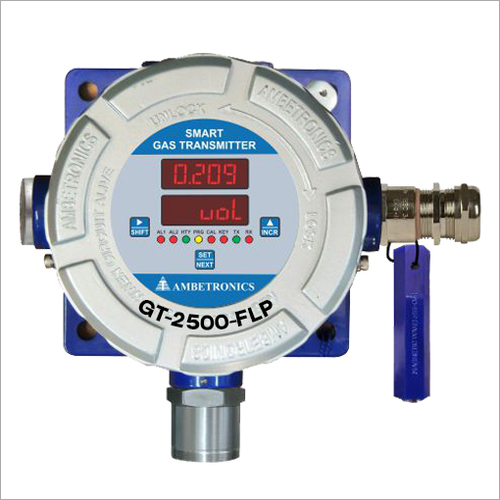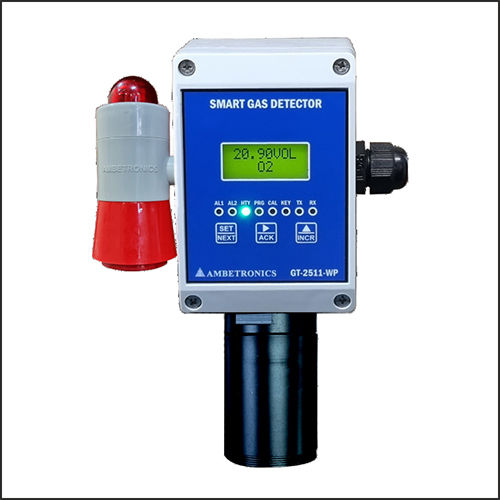- Gas Detector
- Gas Monitors
- Gas Analyzer
- Fixed Data Logger Scanner
- Clean Room Monitoring Equipment
- Internet Of Things (IoT)
- Temperature Humidity Transmitter
- Digital Stroboscope Tachometer
- Vibration Monitoring Equipments
- Gas Detection System
- Process Control Instruments
- Data Loggers
- Portable Gas Detectors
- Process Indicators
- Gas Alarm
- Calibration Kit
- Data Converters
- IIoT Loggers-Gateways
- Temperature Transmitter
- Sensors
- Gas Leak Detector
- Universal Data Logger
- Gas Leak Alert

Digital Gas Transmitter
Product Details:
- Usage Industrial
- Color Blue
- Voltage 220 Volt (v)
- Material Stainless Steel
- Operate Method Automatic
- Power Supply Electric
- Click to view more
Digital Gas Transmitter Price And Quantity
- 1 Piece
Digital Gas Transmitter Product Specifications
- Industrial
- 220 Volt (v)
- Blue
- Electric
- Automatic
- Stainless Steel
Digital Gas Transmitter Trade Information
- Cheque
- 300 Piece Per Day
- 1 Week
- Asia
- All India
Product Description
Here's how a typical digital gas transmitter works:
Advantages of Digital Gas Transmitters:
Digital Gas Transmitter Specifications:
|
Controllers |
DCS,PLC & Ambetronics |
|
Power |
Less than 3.6 Watts. |
|
Output Value |
4-20mA / 20-4mA |
|
Application |
Gas Metering,Oil & Gas Industry,Burner / Furnace Areas. |
|
Brand |
Ambetronics |
|
Depth |
125 mm |
|
Material |
Cast Aluminium alloy,LM-6 |
|
Height |
190mm (H) with sensor holder |
|
Product Weight |
Approx 2.53 Kg |
|
Mounting |
Wall Mounting / Stand Mounting / Pipe Mounting |
|
Protection Type |
IP-66 and for Zone 1 & 2 Gas Group IIC atmosphere; CMRI tested enclosure |
|
Rated Supply Voltage |
Typically 24VDC |
|
Supply Voltage Limits |
18 to 36 VDC |
|
Width |
215 mm (W) with stopper plug & cable gland |
|
Temperature resistant |
Up to 150 deg C |
|
Standard |
IP-65 |
FAQ:
Q. What is a digital gas transmitter?
Ans: A digital gas transmitter is a device used to measure and transmit data about the concentration of a specific gas in the air or a particular environment. It employs digital technology to process the gas sensor's output and communicates the measured data to a central control system or monitoring station.
Q. How does a digital gas transmitter differ from an analog gas detector?
Ans: Analog gas detectors provide continuous voltage or current output proportional to the gas concentration, while digital gas transmitters process the sensor data digitally and communicate it in discrete packets. Digital transmitters typically offer higher accuracy, advanced diagnostic capabilities, and easier integration into control systems.
Q. What gases can a digital gas transmitter detect?
Ans: Digital gas transmitters are available for various gases, including but not limited to carbon dioxide (CO2), methane (CH4), carbon monoxide (CO), hydrogen sulfide (H2S), oxygen (O2), ammonia (NH3), and volatile organic compounds (VOCs).
Q. How is a digital gas transmitter calibrated?
Ans: Calibration involves exposing the gas sensor to known gas concentrations to create a reference for accurate measurements. Manufacturers usually provide calibration instructions, and some transmitters may have automatic calibration features.
Q. What communication protocols do digital gas transmitters use?
Ans: Digital gas transmitters can use different communication protocols, such as Modbus, HART, Profibus, Foundation Fieldbus, or proprietary protocols, to transmit gas concentration data to control systems or monitoring stations.
Q. Can digital gas transmitters be used for outdoor applications?
Ans: Yes, digital gas transmitters can be used in both indoor and outdoor applications. However, for outdoor use, the transmitter should be housed in weatherproof or explosion-proof enclosures to protect it from environmental elements.
Q. How often should digital gas transmitters be maintained?
Ans: Regular maintenance is essential to ensure the accuracy and reliability of digital gas transmitters. The maintenance schedule may vary based on the manufacturer's recommendations and environmental conditions but typically includes sensor calibration and inspection.
Q. Can digital gas transmitters be remotely monitored?
Ans: Yes, many digital gas transmitters offer remote monitoring capabilities, allowing users to access real-time gas concentration data and receive alerts via computer systems or mobile devices.
Q. What are the typical power requirements for digital gas transmitters?
Ans: Digital gas transmitters are typically powered by a stable power source, such as 24V DC. Some transmitters may have low-power consumption features to extend the life of the power supply.
Q. Are digital gas transmitters suitable for hazardous environments?
Ans: Yes, there are digital gas transmitters designed for use in hazardous environments, and they are often rated as explosion-proof to ensure safe operation in such settings.

Price:
- 50
- 100
- 200
- 250
- 500
- 1000+
Other Products in 'Gas Detector' category
 |
AMBETRONICS ENGINEERS PVT. LTD.
All Rights Reserved.(Terms of Use) Developed and Managed by Infocom Network Private Limited. |

 English
English Spanish
Spanish French
French German
German Italian
Italian Chinese (Simplified)
Chinese (Simplified) Japanese
Japanese Korean
Korean Arabic
Arabic Portuguese
Portuguese




